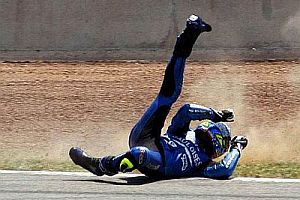The Latest on Motorcycle Safety Gear
 There are few more iconic images than that of the motorcyclist. Whether it’s zipping through traffic when cars are at a standstill or exploring long, winding country highways, motorcycling is many people’s idea of bliss. In order to keep enjoying that bliss, however, it’s necessary to add a dash of caution and common sense. According to statistics from the U.S. Department of Transportation’s National Highway Traffic Safety Administration (NHTSA), motorcyclists are 35 times more likely to experience a deadly road accident than those traveling in passenger vehicles. Even the most skilled motorcyclists need motorcycle safety gear to protect themselves against injury. Remember-more often than not, motorcycle accidents are the fault of people driving other (larger) types of vehicles…
There are few more iconic images than that of the motorcyclist. Whether it’s zipping through traffic when cars are at a standstill or exploring long, winding country highways, motorcycling is many people’s idea of bliss. In order to keep enjoying that bliss, however, it’s necessary to add a dash of caution and common sense. According to statistics from the U.S. Department of Transportation’s National Highway Traffic Safety Administration (NHTSA), motorcyclists are 35 times more likely to experience a deadly road accident than those traveling in passenger vehicles. Even the most skilled motorcyclists need motorcycle safety gear to protect themselves against injury. Remember-more often than not, motorcycle accidents are the fault of people driving other (larger) types of vehicles…
The head, arms and legs are the areas of the body most likely to sustain injury in a motorcycle accident, so protect these first and foremost. The basics of protective clothing include jackets and pants (or a suit), gloves, boots, and of course a helmet. Jackets, pants and gloves can be constructed from leather, nylon or Kevlar. The best quality leather is made from cowhide, as it is the most durable. You can also find pigskin leather that may look nice and be less expensive, but it is far more easily damaged. Be sure the leather is a minimum of one millimeter in thickness for optimal protection. Buffalo hide is another good choice if you can find it.
Many people prefer synthetic materials, due to what some feel is greater comfort and improved weather protection. Whether you choose nylon or Kevlar, test the material to see if it can stretch and breathe. This is important when biking on a hot day. It should also be strong and durable enough to be able to maintain its integrity in the event of an accident.
When choosing a motorcycle jacket, ensure that the stitching at your joints (elbows and shoulders) is strong and preferably reinforced. A well-made jacket will have extra padding in the area of the spine, elbows and shoulders. A jacket of man-made materials should have reflective stripes. Your jacket should fit snugly without being too tight. It should allow for extra layers underneath if you are a cool-weather biker. When trying it on, be sure to also sit in it in riding position to ensure that your back and wrists remain covered while in that position.
Although jeans may be more comfortable, leather pants or chaps are always recommended. In addition to providing greater protection, chaps or insulated pants may be specially coated for water resistance, which is an added bonus in bad weather that jeans just can’t match.
The best gloves (which should be worn at all times, no matter what the weather) will have knuckle protection made from carbon fiber. Cold weather gloves are essentially the same, but with insulation – and often waterproofing – included.
Boots should be at least 6 inches in height to offer ankle protection, and sport a slip-resistant sole. Thicker soles are better at absorbing bike vibrations. Leather boots are always preferable to nylon running shoes, which offer no protection to your feet and ankles in case of an accident.
The use of brightly colored, reflective clothing has been shown to reduce the risk of road accidents by 37%. If your clothing does not have reflectivity built-in, you can add it with the addition of reflective tape kits. Anything that makes you more visible to other drivers can dramatically decrease your risk of an injury.
Although nobody enjoys wearing a motorcycle helmet, it may make the difference between life and death (or between life and living in a vegetative state). A good helmet will have a Department of Transportation (DOT) certification sticker on the back. This ensures that the helmet meets stringent safety requirements. You will get the most protection from a full coverage helmet that covers the entire head and face, with a clear acrylic visor for added protection against insects and various light road debris. Many helmets also feature vents to help keep your head cool.
A well-equipped biker is a happy, healthy one, so buy some quality gear and get out there to enjoy the open road!